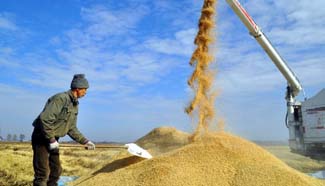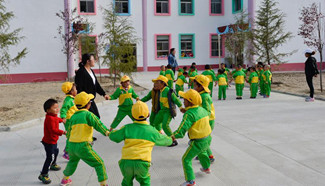NANJING, Oct. 13 (Xinhua) -- Chinese scientists announced Thursday they have looked into three giant meteorite irons to ascertain the world's longest meteorite-strewn field in Altay, Xinjiang Uygur Autonomous Region.
Scientists with the Purple Mountain Observatory in Nanjing, capital of the eastern province of Jiangsu, said Thursday that the meteorites were all from the same parent asteroid, as their chemical elements are identical.
The earliest dated discovery of the extraterrestrial stones was in 1898, when herdsmen in the Gobi Desert found a 28-tonne silvery stone, which was in the shape of a camel. The Meteoritic Society later named it Armanty, and confirmed it to be the world's fourth-largest meteorite.
Over 100 years later, a second one was found. It weighed 430 kg and was named Ulasitai.
It was not until 2011, when a third one -- Wuxilike -- weighing 5 tonnes was found, that scientists began to notice that the three meteorite were in a line, although across a distance of 425 km.
"They are on the same axis from southeast to northwest, which piqued our interest," said Xu Weibiao, meteorite curator with the observatory under the Chinese Academy of Sciences (CAS).
Xu, one of the chief scientists with the mineralogical research arm of the meteorites, said the meteorites were composed of the same chemical components and microelements.
Several smaller meteorites have also been found in the field, all with the same chemical composition as the larger rocks.
"This suggests that the meteorites were all from the same parent asteroid before it separated as it entered the Earth' atmosphere," said Xu.
HOW BIG WAS THE METEOR SHOWER?
An ordinary meteor shower can scatter meteorites across dozens of kilometers.
Before the finding in Altay, the world's largest meteorite strewn field was Gibeon, with a long axis of 275 km.
Judging by the 425-km strewn length of the Altay field, its meteor shower is likely the largest on the Earth.
However, there is no historical documentation on the incident. Scientists speculate it might have happened prehistorically.
"A meteor shower of such a scale must have had a great impact on the Earth. If it happened after humans walked the earth, we often find cave painting depicting the incident in the area," said Xu.
He said the team has used isotopic dating to determine when the meteor shower occurred.
An average of 20,000 meteorites fall to the Earth every year. Scientists use extraterrestrial stones to determine information about the universe and life signs in space through chemical classification.
For example, scientists previously discovered evidence of magma activity on Mars some 200 million years ago after sampling a meteorite.
In 2017, China will launch the Chang'e-5 lunar probe, which will collect samples from the moon.
"For the moon sample research, the observatory will use more advanced analytical equipment, which will greatly assist our petrological and mineralogical research," Xu said. Enditem










